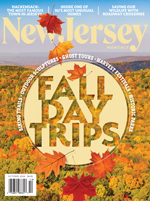Bubble tea began as a kids’ craze in Taiwan in the 1980s. A blend of (usually iced) tea and flavorings such as honeydew or almond, with or without milk or nondairy creamer, it was served whipped to a froth in a big plastic cup. The froth gave it its name, but the signature ingredient was dark, squishy tapioca balls (also called boba or pearls) to be sucked up through an extra-wide straw. The fad did not fade but made its way across Asia, from Vietnam to the Philippines, then to California and on to American cities with Asian populations, where the drink has been endlessly customized over the last ten years. In New Jersey, bubble tea is winning converts ready to try something new after their millionth iced Frappuccino. But it also evokes nostalgia among Asian émigrés.
“I went to school in Hong Kong, where it was hot and humid. Bubble tea was my favorite drink growing up,” says John Sin, 36, co-owner of Babo Teahouse in Jersey City’s Newport development along the Hudson River. “I remember an old man on a bicycle carrying buckets of ice and red tea—the schoolkids lined up to buy it.”
Babo serves snacks and gelato as well as a wide range of traditional hot teas in a hip urban setting that invites hanging out. At Babo, as at most bubble-tea bars, devotees tend to divide into two camps: fruity or milky. Fruity bubble tea is made with freshly brewed green tea with natural fruit syrup, tapioca balls, and perhaps some sugar. The milky version is made with black tea and flavored powders that run the gamut from watermelon and blueberry to Ovaltine and taro.
Though the original milky ingredient was probably coconut milk (indigenous to Asia) or canned condensed milk (brought by European and French colonists), the ingredient of choice nowadays is nondairy creamer. At Babo and most other places, you can ask for fresh milk. If you don’t want your drink super sweet, you can also ask them not to add extra sugar.
Commercial mixes and powders have taken the business by storm, but some places still make bubble tea from scratch. At Terra Tea Salon and Fair Trade Eco Market in Montclair, co-owner Grace Chow Grund, 45, uses freshly brewed teas and fresh milk, because she’s not sure her American customers would enjoy the coconut-milk version she drank in Singapore in her youth. (She keeps some in the back for herself.) She also has fond memories of a similar drink called chendol. It came to Singapore by way of Malaysia, with tapioca in worm shapes. “We called it worm tea in kindergarten,” says Grund with a laugh. “But nobody here would go for that.”
Far from a fad, bubble tea is rooted in traditional Asian dessert puddings, sweet soups, and iced jelly drinks. In Southeast Asia, a popular drink called falooda contains basil seeds soaked to a jelly-like consistency, mixed with fruit juices. Falooda has not yet arrived. Its day will come. Meanwhile, bubble tea will get you ready.



